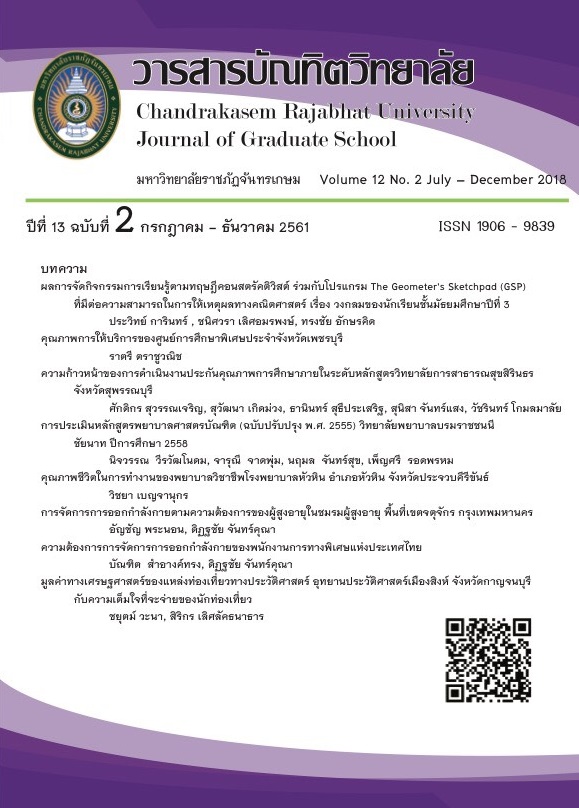ความก้าวหน้าของการดำเนินงานประกันคุณภาพการศึกษาภายในระดับหลักสูตร วิทยาลัยการสาธารณสุขสิรินธร จังหวัดสุพรรณบุรี
Main Article Content
บทคัดย่อ
การวิจัยเชิงพัฒนาการครั้งนี้ มีวัตถุประสงค์เพื่อวิเคราะห์แนวโน้มและความก้าวหน้าของผลการตรวจประเมินคุณภาพการศึกษาภายในระดับหลักสูตร และปัจจัยที่ส่งผลต่อการดำเนินการประกันคุณภาพการศึกษาภายในระดับหลักสูตร หลักสูตรสาธารณสุขศาสตรบัณฑิต (หลักสูตรใหม่ พ.ศ. 2555 และ หลักสูตรปรับปรุง พ.ศ. 2559) ตั้งแต่
ปีการศึกษา 2557 ถึง 2559 เก็บรวบรวมข้อมูลจากผลการตรวจประเมินคุณภาพการศึกษาภายในระดับหลักสูตร จากคณะกรรมการของสถาบันพระบรมราชชนก ที่เข้าตรวจประเมินคุณภาพในปีการศึกษา 2557 และ 2559 และจากสถาบันวิชาการสาธารณสุขเทคโนโลยีทางการแพทย์ ในปีการศึกษา 2558 วิเคราะห์ข้อมูลทั้ง 6 องค์ประกอบ 14 ตัวบ่งชี้ ครอบคลุมทั้งด้านปัจจัยนำเข้า กระบวนการและผลลัพธ์ โดยเปรียบเทียบความแตกต่างของผลการประเมินด้วยสถิติ Mann-Whitney Rank Sum Test และวิเคราะห์ข้อมูลจากเอกสารด้วยการวิเคราะห์เนื้อหา
ผลการศึกษา พบว่ามีแนวโน้มผลการดำเนินงานทั้ง 6 องค์ประกอบ ในภาพรวมที่ดีขึ้นระหว่างปีการศึกษา 2557 ถึง 2559 (ผลคะแนนเฉลี่ยเท่ากับ 3.04 3.20 และ 3.40 ตามลำดับ) สำหรับตัวบ่งชี้ที่ 1.1 พบว่า หลักสูตรได้มาตรฐานตามเกณฑ์มาตรฐานหลักสูตรระดับปริญญาตรี พ.ศ. 2548 และ 2558 โดยในปีการศึกษา 2557 และ 2559 พบความแตกต่างของผลการประเมินอย่างมีนัยสำคัญทางสถิติ (p<0.5) เมื่อพิจารณาด้านปัจจัยนำเข้า กระบวนการและผลลัพธ์ พบว่าผลคะแนนด้านปัจจัยนำเข้า (ประกอบด้วยตัวบ่งชี้ที่ 3.1 3.2 3.3 4.1 4.2 4.3 และ 5.1) มีแนวโน้มที่ดีขึ้นระหว่างปีการศึกษา 2557 ถึง 2559 โดยมีคะแนนเท่ากับ 2.85 3.10 และ 3.25 ตามลำดับ ด้านกระบวนการ (ประกอบด้วยตัวบ่งชี้ที่ 5.2 5.3 5.4 และ 6.1 ) มีแนวโน้มลดลงในปีการศึกษา 2558 และพัฒนาขึ้นในปีการศึกษา 2559 โดยมีคะแนนเท่ากับ 3.50 3.13 และ 3.44 ตามลำดับ และด้านผลลัพธ์ (ประกอบด้วยตัวบ่งชี้ที่ 2.1 และ 2.2) ยังไม่สามารถบอกแนวโน้มได้ เนื่องจากมีบัณฑิตจบในหลักสูตร ในปีการศึกษา 2558 เป็นปีแรก ปัจจัยที่ส่งผลให้คะแนนการประเมินคุณภาพการศึกษาภายในของหลักสูตรมีแนวโน้มที่ดีขึ้น คือ 1) การดำเนินงานตามวงจร PDCA 2) การทบทวนกระบวนการ จากผลการประเมินของคณะกรรมการและการดำเนินงานเพื่อจัดทำแผนพัฒนาคุณภาพและสรุป ติดตาม ประเมินผลเป็นระยะ 3) การพัฒนาศักยภาพอาจารย์ผู้รับผิดชอบหลักสูตร 4) การบูรณาการงานประกันคุณภาพการศึกษากับงานบริหารหลักสูตรหรืองานประจำ และ 5) การจัดการความรู้เรื่องการพัฒนาระบบและกลไกการประกันคุณภาพการศึกษาภายในระดับหลักสูตร จากผลการศึกษาแสดงให้เห็นว่ามีผลการดำเนินงานที่ก้าวหน้าขึ้นตั้งแต่ปีการศึกษา 2557 ถึง 2559 ซึ่งสามารถนำไปจัดทำแนวปฏิบัติที่ดีในการดำเนินงานประกันคุณภาพการศึกษาภายในระดับหลักสูตร และนำไปวางแผน ปรับปรุงพัฒนาการดำเนินงานต่อไป
Article Details
เอกสารอ้างอิง
2. คณะกรรมการประเมินคุณภาพการศึกษาภายใน ระดับหลักสูตร ปีการศึกษา 2558. (2558). รายงานผลการประเมินคุณภาพการศึกษาภายในระดับหลักสูตร หลักสูตรสาธารณสุขศาสตรบัณฑิต สาขาวิชาสาธารณสุขชุมชน (หลักสูตรใหม่ พ.ศ. 2555) ประจำปีการศึกษา 2558. สถาบันวิชาการสาธารณสุขเทคโนโลยีทางการแพทย์: สถาบันพระบรมราชชนก สำนักงานปลัดกระทรวงสาธารณสุข.
3. คณะกรรมการประเมินคุณภาพการศึกษาภายใน ระดับหลักสูตร ปีการศึกษา 2559. (2559). รายงานผลการประเมินคุณภาพการศึกษาภายในระดับหลักสูตร หลักสูตรสาธารณสุขศาสตรบัณฑิต สาขาวิชาสาธารณสุขชุมชน (หลักสูตรปรับปรุง พ.ศ. 2559) ประจำปีการศึกษา 2559. นนทบุรี: สถาบันพระบรมราชชนก สำนักงานปลัดกระทรวงสาธารณสุข.
4. จงกล จันทร์เรื่อง, ธนินทร์ ระเบียบโพธิ์, และเอกลักษณ์ ฉิมจารย์. (2556). การบูรณาการงานประกันคุณภาพการศึกษากับการจัดการเรียนการสอน การบริการวิชาการแก่สังคมและงานวิจัย. วารสาร มทร อีสาน, 6(1), 94-103.
5. เบญจวรรณ วงศ์ปราชญ์. (2560). ระบบและกลไกการประกันคุณภาพการศึกษาภายใน วิทยาลัยพยาบาลกองทัพบก. วารสารพยาบาลทหารบก, 18(3), 16-25.
6. ปาริฉัตร จันทร์นวล และธีระวัฒน์ จันทึก. (2558). การคาดการณ์ระดับความสำเร็จในการบริหารงานด้านการประกันคุณภาพการศึกษาภายในระดับหลักสูตรของมหาวิทยาลัยราชภัฎสวนสุนันทา. วารสารบัณฑิตศึกษา มหาวิทยาลัยราชภัฏสวนสุนันทา, 2(2), 164-181.
7. สำนักงานคณะกรรมการการอุดมศึกษา กระทรวงศึกษาธิการ. (2557). คู่มือการประกันคุณภาพการศึกษาภายในระดับอุดมศึกษา พ.ศ. 2557 (พิมพ์ครั้งที่ 4). กรุงเทพฯ: ภาพพิมพ์.
8. สำนักมาตรฐานและประเมินผลอุดมศึกษา สำนักงานคณะกรรมการการอุดมศึกษา กระทรวงศึกษาธิการ. (2560). เกณฑ์มาตรฐานหลักสูตรระดับอุดมศึกษา พ.ศ. 2558 และเกณฑ์มาตรฐานที่เกี่ยวข้อง. กรุงเทพฯ: วงศ์สว่างพับลิชชิ่ง แอนด์ พริ้นติ้ง.
9. Demimg, W.E. The Deming Cycle. (1993). The New Economics for Industry, Government, Education. Cambridge MA: MIT Press.


